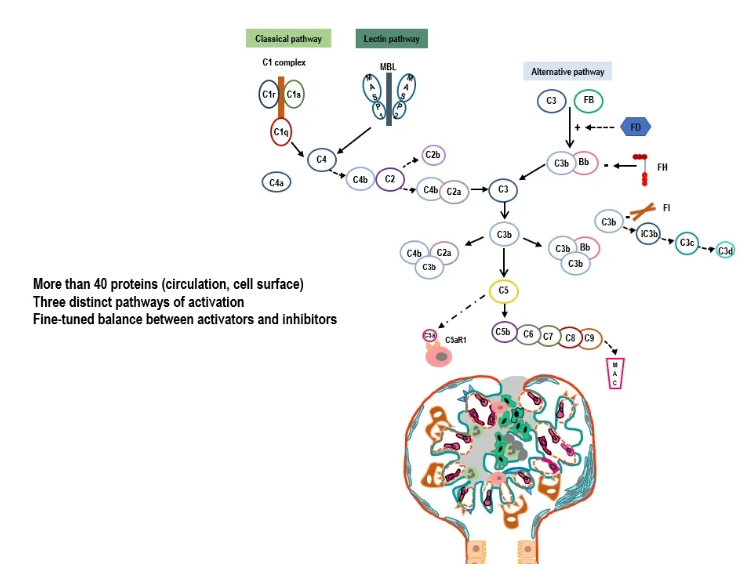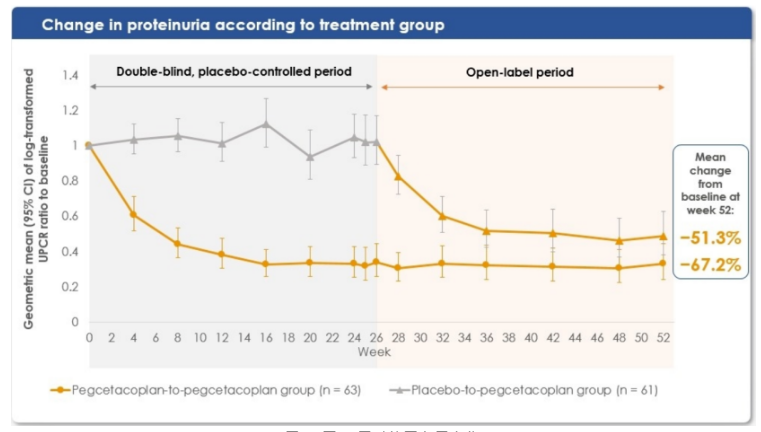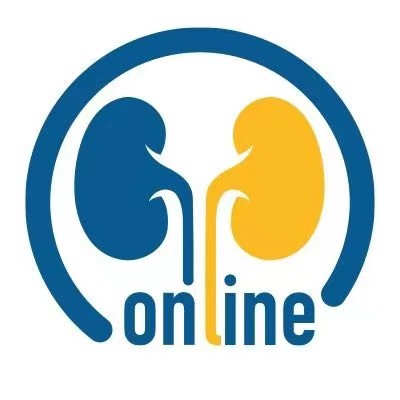- 首页 > 正文
ERA大咖谈丨Ⅲ期VALIANT试验52周数据揭晓:加速补体抑制疗法革新
发表时间:2025-08-19 14:55:48
编者按:在第62届欧洲肾脏协会(ERA)年会上,瑞士洛桑大学附属医院(CHUV)肾脏病学教授Fadi Fakhouri博士聚焦补体抑制疗法及其在C3肾小球病(C3G)和原发性免疫复合物膜增生性肾小球肾炎(IC-MPGN)中的应用进行学术报告,揭示了临床需要多种补体抑制剂的核心逻辑,并分享了Pegcetacoplan治疗C3G和原发性(特发性)IC-MPGN的Ⅲ期VALIANT试验的52周结果详细数据。肾医线就此话题对Fadi Fakhouri博士进行了专访,本文整理Fadi Fakhouri博士的大会报告及采访的主要内容,与广大肾脏病医生共享。
一、补体系统复杂性驱动多样化治疗需求
“补体系统包含40余种蛋白质,通过经典、凝集素和替代三条途径激活,不同肾脏疾病中补体的致病机制差异显著。”Fakhouri指出,“炎症性损伤多由C5激活介导,而C3G的关键驱动因素是C3沉积”。这种机制异质性要求治疗必须“精准靶向”——例如针对替代途径失调的C3G,需特异性抑制C3转化酶,而炎症为主的疾病则需靶向C5。此外,同一患者在疾病不同阶段的补体活化模式可能动态变化,进一步凸显了多样化抑制剂的必要性。
他以图表展示补体系统级联反应(图1):经典途径从C1复合物启动,替代途径依赖C3b与B因子结合,而终末途径共同形成膜攻击复合物(MAC)。“就像交响乐团需要不同乐器协作,补体系统的精密平衡一旦打破,就需要不同‘调节器’来纠正。”他强调,这种复杂性也体现在临床——约50%~80%的C3G患者存在C3肾炎因子,4%~12%携带抗H因子抗体(Kidney Int. 2020 Nov;98(5):1135-1148.),不同抗体亚型对应不同的治疗靶点。

图1. 复杂的补体系统
Nephrology On-line: Your presentations highlight the evolving role of complement inhibition in treating C3G and primary IC-MPGN. Could you explain why multiple different complement inhibitors are needed in clinical practice?
Dr Fakhouri: As you know, the complement system is very complex, and even the involvement of complement in different kidney diseases relies on different molecules in the complement system. So, we need different therapeutic targets. For example, inflammation is more mediated by C5 activation. Whereas in C3G, the main driver is C3 deposition. So, you have different mechanisms of injury to the kidney due to complement, and we need to target each one specifically depending on the context of the disease, even sometimes, depending on the course of the disease, over time in a single patient.
二、VALIANT试验:补体抑制的长期疗效验证
针对Pegcetacoplan(培西他普)的Ⅲ期VALIANT试验数据成为本次报告的焦点。该试验为随机前瞻性试验,旨在评估Pegcetacoplan在青少年和成人C3G及免疫复合物性疾病患者中的疗效,共纳入124例患者。
在报告中,Fakhouri教授展示了治疗前后的肾活检对比:基线时弥漫性C3c阳性的肾小球,在26周的Pegcetacoplan治疗后转为阴性。机制上,该药物通过抑制C3转化酶,阻断C3b生成及下游炎症级联,从而减少肾小球损伤。试验还证实,治疗26周时,无论患者年龄(12岁以上)、疾病类型(C3G或IC-MPGN)、移植状态或基线蛋白尿水平,疗效均一致。例如,基线蛋白尿≥3 g/g的患者治疗后蛋白尿减少72.1%,合并免疫抑制剂治疗的患者也获得70.3%的降幅。
治疗52周(1年)时的结果显示,无论是初始即接受治疗还是6个月后从安慰剂转用Pegcetacoplan的患者,蛋白尿分别减少51%和67%(图2)——这种降幅在肾小球疾病中极为罕见。更值得关注的是,71%的患者在26周重复肾活检中显示C3c沉积完全清除,“传统治疗中,C3沉积的逆转几乎难以想象。”C3c 沉积的逆转是C3G和IC-MPGN患者疗效的关键标志。
此外,估算肾小球滤过率(eGFR)在一年内保持稳定。安慰剂组在初始六个月内 eGFR 有下降趋势,但转为Pegcetacoplan治疗后,肾功能有所恢复,最终 eGFR 与初始即接受治疗的患者相似。基于蛋白尿减少、肾脏C3c清除和 eGFR 早期稳定,VALIANT试验的这些结果令人瞩目。
图片
图2. 至52周时的蛋白尿变化
安全性方面,药物相关不良事件多为轻度输液反应,未出现脑膜炎球菌感染等严重并发症,长期使用的安全性与短期数据一致。这为临床提供了重要参考:Pegcetacoplan不仅疗效显著,且可避免糖皮质激素的副作用,尤其适用于需长期治疗的患者。
Nephrology On-line: The VALIANT trial with pegcetacoplan has shown sustained efficacy over 52 weeks in patients with C3G and IC-MPGN. What are the key clinical implications of these results for patients and clinicians?
Dr Fakhouri: The VALIANT study was a randomized prospective trial assessing the efficacy of pegcetacoplan in C3 glomerulopathy (C3G) and immune complex in adolescent and adult patients. After six months, all the placebo group was switched to pegcetacoplan. Here, we present the data at 52 weeks, one year, that are impressive. To make it simple for you, I'm going to give you just three figures – 51-67%0% reduction in proteinuria in patients who were from the beginning on pegcetacoplan and patients switched from placebo to pegcetacoplan, respectively; Such reduction in proteinuria is rarely seen in glomerular diseases. Besides, 71% of patients clearing all their C3c deposits in the kidney at a repeat kidney biopsy at 26 weeks (which is in my point of view a very impressive finding, because we are not very accustomed to seeing that);. The reversal of C3c deposits is a key finding of efficacy in C3G patients and immune complex-mediated membranoproliferative glomerulonephritis (IC-MPGN) patients. The short finding is that you have a stabilization of eGFR over one year. The placebo group tended to decrease in the initial six months, and then when they were switched to pegcetacoplan, they regained some renal function and, at the end, the eGFR was similar to those patients treated from the beginning with pegcetacoplan. Very impressive results based on proteinuria reduction, C3c removal from the kidney, and stabilization of eGFR as early as one year.

Fakhouri教授指出:“当前,我们正处于快速变革的时代,补体抑制剂将在不同适应证中找到定位。”面对补体介导性肾病的治疗前景,Fakhouri教授勾勒出清晰的发展蓝图:
抗炎药物的迭代升级:C5抑制剂有望取代糖皮质激素,成为炎症性肾病的一线选择。“患者可以告别激素导致的骨质疏松、感染风险,同时获得更持久的肾脏缓解。”
精准靶向治疗的普及:从“一刀切”的全身性抑制转向精准调控。例如,替代途径异常的C3G患者可靶向C3转化酶,而经典途径激活为主的疾病则需抑制C1复合物。这种“病理机制导向”的治疗模式将大幅提升疗效。
可及性与成本优化:随着更多企业入局补体领域以及更多补体药物上市,药物价格有望下降。竞争将推动技术创新,促进药物价格下降,使全球患者有能力负担并获得治疗。
Nephrology On-line: How do you envision the treatment paradigm for complement-mediated kidney diseases evolving in the next 5 to 10 years, and what research questions are most urgent to address?
Dr Fakhouri: This is a very excellent question, because I think we are living in very changing, moving times and complement inhibitors will find their place in different indications. For example, I see in the future that C5 inhibitors will replace corticosteroids sooner or later as anti-inflammatory drugs in inflammatory kidney disease. This would be a great change for doctors, but especially for patients. They could be spared the side effects of corticosteroids while achieving potentially a better renal remission. The second change I see is that we are moving towards a more targeted, specific pathogenesis-based approach to disease, where if you have an alternative pathway dysregulated, you have to target the alternative pathway. So, we are moving towards a fine-tuned, precise inhibition of the complement system, not a global inhibition like we had initially with C5 inhibition. And the third trend I see is a decrease in price due to the increase in the number of drugs and companies involved in the complement field, which would be good news for patients because decrease in price would make it more affordable and more easily available for patients worldwide.
四、补体领域:下一个肾脏病学革新前沿
“两三年前,SGLT2抑制剂和GLP-1受体激动剂引领了代谢性肾病的突破;如今,补体抑制正在开启新的治疗纪元。”Fakhouri在访谈中感慨。在ERA年会的众多议题中,补体抑制专场无疑成为焦点。从基础研究到临床转化的加速,将让补体靶向治疗成为继免疫抑制剂之后的又一里程碑。
Nephrology On-line: You have probably given a lot of talks, also joined a lot of sessions. Have you seen any sessions that you think are particularly interesting?
Dr Fakhouri: I think the complement inhibition is making a great revolution. Two or three years ago, we had the SGLT2 inhibitors and GLP-1 receptor agonists emerging into the light, and now it is time for complement inhibition. That is why I'm very happy to be here.
总结及展望
肾脏疾病治疗的范式正发生重要变革,尤其是补体治疗领域。除Pegcetacoplan外,针对C5、C1q、H因子等靶点的抑制剂已进入不同研发阶段,形成覆盖补体全通路的治疗矩阵。这不是单一药物的胜利,而是整个领域对疾病机制深入理解的成果。随着精准医学和人工智能在生物标志物发现中的应用,补体抑制疗法将进一步个性化,为终末期肾病的预防带来希望。
未来肾脏疾病的诊断不仅要依赖肾活检,更要结合血液和尿液中的补体活化标志物,如 C3a、C5a,实现疗效的动态监测。” 此外,如何确定最佳治疗疗程、筛选能安全停药的患者,以及探索补体抑制剂与其他靶向药物的联合方案,都是亟待解决的课题。
一、补体系统复杂性驱动多样化治疗需求
“补体系统包含40余种蛋白质,通过经典、凝集素和替代三条途径激活,不同肾脏疾病中补体的致病机制差异显著。”Fakhouri指出,“炎症性损伤多由C5激活介导,而C3G的关键驱动因素是C3沉积”。这种机制异质性要求治疗必须“精准靶向”——例如针对替代途径失调的C3G,需特异性抑制C3转化酶,而炎症为主的疾病则需靶向C5。此外,同一患者在疾病不同阶段的补体活化模式可能动态变化,进一步凸显了多样化抑制剂的必要性。
他以图表展示补体系统级联反应(图1):经典途径从C1复合物启动,替代途径依赖C3b与B因子结合,而终末途径共同形成膜攻击复合物(MAC)。“就像交响乐团需要不同乐器协作,补体系统的精密平衡一旦打破,就需要不同‘调节器’来纠正。”他强调,这种复杂性也体现在临床——约50%~80%的C3G患者存在C3肾炎因子,4%~12%携带抗H因子抗体(Kidney Int. 2020 Nov;98(5):1135-1148.),不同抗体亚型对应不同的治疗靶点。

图1. 复杂的补体系统
Nephrology On-line: Your presentations highlight the evolving role of complement inhibition in treating C3G and primary IC-MPGN. Could you explain why multiple different complement inhibitors are needed in clinical practice?
Dr Fakhouri: As you know, the complement system is very complex, and even the involvement of complement in different kidney diseases relies on different molecules in the complement system. So, we need different therapeutic targets. For example, inflammation is more mediated by C5 activation. Whereas in C3G, the main driver is C3 deposition. So, you have different mechanisms of injury to the kidney due to complement, and we need to target each one specifically depending on the context of the disease, even sometimes, depending on the course of the disease, over time in a single patient.
二、VALIANT试验:补体抑制的长期疗效验证
针对Pegcetacoplan(培西他普)的Ⅲ期VALIANT试验数据成为本次报告的焦点。该试验为随机前瞻性试验,旨在评估Pegcetacoplan在青少年和成人C3G及免疫复合物性疾病患者中的疗效,共纳入124例患者。
在报告中,Fakhouri教授展示了治疗前后的肾活检对比:基线时弥漫性C3c阳性的肾小球,在26周的Pegcetacoplan治疗后转为阴性。机制上,该药物通过抑制C3转化酶,阻断C3b生成及下游炎症级联,从而减少肾小球损伤。试验还证实,治疗26周时,无论患者年龄(12岁以上)、疾病类型(C3G或IC-MPGN)、移植状态或基线蛋白尿水平,疗效均一致。例如,基线蛋白尿≥3 g/g的患者治疗后蛋白尿减少72.1%,合并免疫抑制剂治疗的患者也获得70.3%的降幅。
治疗52周(1年)时的结果显示,无论是初始即接受治疗还是6个月后从安慰剂转用Pegcetacoplan的患者,蛋白尿分别减少51%和67%(图2)——这种降幅在肾小球疾病中极为罕见。更值得关注的是,71%的患者在26周重复肾活检中显示C3c沉积完全清除,“传统治疗中,C3沉积的逆转几乎难以想象。”C3c 沉积的逆转是C3G和IC-MPGN患者疗效的关键标志。
此外,估算肾小球滤过率(eGFR)在一年内保持稳定。安慰剂组在初始六个月内 eGFR 有下降趋势,但转为Pegcetacoplan治疗后,肾功能有所恢复,最终 eGFR 与初始即接受治疗的患者相似。基于蛋白尿减少、肾脏C3c清除和 eGFR 早期稳定,VALIANT试验的这些结果令人瞩目。
图片
图2. 至52周时的蛋白尿变化
安全性方面,药物相关不良事件多为轻度输液反应,未出现脑膜炎球菌感染等严重并发症,长期使用的安全性与短期数据一致。这为临床提供了重要参考:Pegcetacoplan不仅疗效显著,且可避免糖皮质激素的副作用,尤其适用于需长期治疗的患者。
Nephrology On-line: The VALIANT trial with pegcetacoplan has shown sustained efficacy over 52 weeks in patients with C3G and IC-MPGN. What are the key clinical implications of these results for patients and clinicians?
Dr Fakhouri: The VALIANT study was a randomized prospective trial assessing the efficacy of pegcetacoplan in C3 glomerulopathy (C3G) and immune complex in adolescent and adult patients. After six months, all the placebo group was switched to pegcetacoplan. Here, we present the data at 52 weeks, one year, that are impressive. To make it simple for you, I'm going to give you just three figures – 51-67%0% reduction in proteinuria in patients who were from the beginning on pegcetacoplan and patients switched from placebo to pegcetacoplan, respectively; Such reduction in proteinuria is rarely seen in glomerular diseases. Besides, 71% of patients clearing all their C3c deposits in the kidney at a repeat kidney biopsy at 26 weeks (which is in my point of view a very impressive finding, because we are not very accustomed to seeing that);. The reversal of C3c deposits is a key finding of efficacy in C3G patients and immune complex-mediated membranoproliferative glomerulonephritis (IC-MPGN) patients. The short finding is that you have a stabilization of eGFR over one year. The placebo group tended to decrease in the initial six months, and then when they were switched to pegcetacoplan, they regained some renal function and, at the end, the eGFR was similar to those patients treated from the beginning with pegcetacoplan. Very impressive results based on proteinuria reduction, C3c removal from the kidney, and stabilization of eGFR as early as one year.

Fakhouri教授指出:“当前,我们正处于快速变革的时代,补体抑制剂将在不同适应证中找到定位。”面对补体介导性肾病的治疗前景,Fakhouri教授勾勒出清晰的发展蓝图:
抗炎药物的迭代升级:C5抑制剂有望取代糖皮质激素,成为炎症性肾病的一线选择。“患者可以告别激素导致的骨质疏松、感染风险,同时获得更持久的肾脏缓解。”
精准靶向治疗的普及:从“一刀切”的全身性抑制转向精准调控。例如,替代途径异常的C3G患者可靶向C3转化酶,而经典途径激活为主的疾病则需抑制C1复合物。这种“病理机制导向”的治疗模式将大幅提升疗效。
可及性与成本优化:随着更多企业入局补体领域以及更多补体药物上市,药物价格有望下降。竞争将推动技术创新,促进药物价格下降,使全球患者有能力负担并获得治疗。
Nephrology On-line: How do you envision the treatment paradigm for complement-mediated kidney diseases evolving in the next 5 to 10 years, and what research questions are most urgent to address?
Dr Fakhouri: This is a very excellent question, because I think we are living in very changing, moving times and complement inhibitors will find their place in different indications. For example, I see in the future that C5 inhibitors will replace corticosteroids sooner or later as anti-inflammatory drugs in inflammatory kidney disease. This would be a great change for doctors, but especially for patients. They could be spared the side effects of corticosteroids while achieving potentially a better renal remission. The second change I see is that we are moving towards a more targeted, specific pathogenesis-based approach to disease, where if you have an alternative pathway dysregulated, you have to target the alternative pathway. So, we are moving towards a fine-tuned, precise inhibition of the complement system, not a global inhibition like we had initially with C5 inhibition. And the third trend I see is a decrease in price due to the increase in the number of drugs and companies involved in the complement field, which would be good news for patients because decrease in price would make it more affordable and more easily available for patients worldwide.
四、补体领域:下一个肾脏病学革新前沿
“两三年前,SGLT2抑制剂和GLP-1受体激动剂引领了代谢性肾病的突破;如今,补体抑制正在开启新的治疗纪元。”Fakhouri在访谈中感慨。在ERA年会的众多议题中,补体抑制专场无疑成为焦点。从基础研究到临床转化的加速,将让补体靶向治疗成为继免疫抑制剂之后的又一里程碑。
Nephrology On-line: You have probably given a lot of talks, also joined a lot of sessions. Have you seen any sessions that you think are particularly interesting?
Dr Fakhouri: I think the complement inhibition is making a great revolution. Two or three years ago, we had the SGLT2 inhibitors and GLP-1 receptor agonists emerging into the light, and now it is time for complement inhibition. That is why I'm very happy to be here.
总结及展望
肾脏疾病治疗的范式正发生重要变革,尤其是补体治疗领域。除Pegcetacoplan外,针对C5、C1q、H因子等靶点的抑制剂已进入不同研发阶段,形成覆盖补体全通路的治疗矩阵。这不是单一药物的胜利,而是整个领域对疾病机制深入理解的成果。随着精准医学和人工智能在生物标志物发现中的应用,补体抑制疗法将进一步个性化,为终末期肾病的预防带来希望。
未来肾脏疾病的诊断不仅要依赖肾活检,更要结合血液和尿液中的补体活化标志物,如 C3a、C5a,实现疗效的动态监测。” 此外,如何确定最佳治疗疗程、筛选能安全停药的患者,以及探索补体抑制剂与其他靶向药物的联合方案,都是亟待解决的课题。
- 推荐文章
2024 ASN年会HIV相关肾病研究进展
ASN中国之声 | 北京世纪坛医院罗洋主任:血液透析过程中脑血流量反复下降可能是老年患者认知功能恶化的潜在机制之一
KI Rep丨达格列净联合托伐普坦延缓ADPKD病情进展:一项开放标签、随机、对照、交叉试验
肾域华章丨南方医科大学南方医院儿科孙良忠团队揭示肾消耗病关键发病机制
一文说清原发性膜性肾病蛋白尿缓解的传统和新兴预测因素
肾例明鉴 | 与IgA肾病及C3沉积相关的快速进展性肾小球肾炎合并慢性乙型肝炎病例一例
罕见但致命的肾小球病:一项英国多中心队列研究揭示纤维性肾小球病的临床特点与预后
泰它西普治疗儿童IgA肾病与IgA血管炎肾炎的疗效与安全性回顾分析
2025肾脏病学半年报:从突破性新药到异种移植,这些进展改写临床格局
生物标志物引领下的急性肾损伤精准诊疗:从困境到突破
以靶向治疗应对钙化防御:IL-6是关键突破口?
强直性脊柱炎还会“伤肾”吗?警惕强直性脊柱炎的肾脏损害
FDA扩大非奈利酮适应证,惠及更多心力衰竭患者
伊普可泮与Pegcetacoplan治疗原发性膜增生性肾小球肾炎的真实世界证据
研究者解读:CONFIDENCE试验——非奈利酮与恩格列净联合治疗的突破性发现
泰它西普治疗IgA肾病的研究进展:来自真实世界研究的数据
ERA前主席C. Wanner教授专访:心肾轴与慢性肾脏病管理新进展
来自Ⅲ期APPEAR-C3G研究的最新数据:伊普可泮快速持续改善C3水平、减少血尿和蛋白尿
肾例明鉴丨5旬肾友拿不住筷子、双手无力无感觉竟是因为它?透析15年以上几乎100%中招!
肾识百科丨IgA肾病患者必知:感染如何“兴风作浪”及防范之策
特应性皮炎竟是IgA肾病“隐形推手”,银屑病关联成谜引学界热议
JASN丨首个针对C3肾小球病患者使用C5a受体阻断剂阿伐可泮的ACCOLADE研究结果公布
赵建荣教授:髓质海绵肾研究新进展
NDT丨IgA肾病患者时间平均UPCR>2 g/g,肾脏复合终点事件风险达41.2
慢性肾病进展快?《延缓慢性肾脏病进展临床管理指南(2025年版)》揭秘6大延缓妙招,护肾关键全在这!
2025年ERA关于IgA肾病的这些新证据您可能不知道
首次揭示红斑狼疮持续缓解至少3年,可显著降低LN及总体器官累积损伤风险
大型亚洲队列研究新鲜出炉:CKM综合征65.8%处于1~2期,显著增加患者心肾死亡风险、缩短预期寿命
肾例明鉴 | 两例IgG4相关性肾病合并单克隆丙种球蛋白病的诊疗解析及文献回顾
ERA 2025伊普可泮治疗IgA肾病相关研究进展
年纪轻轻肾就坏了?了解罕见的青少年肾单位肾痨-髓质囊肿病,揭开医学谜题
ALIGN研究事后分析揭示阿曲生坦对IgA肾病亚组蛋白尿的降低作用
APSN前任主席Sydney Tang教授:SPARTACUS试验的临床意义及IgA肾病治疗进展
ERA 2025替那帕诺研究:破解血液透析患者高磷血症管理新密码
聚焦肾脏与大脑健康的跨学科探索——2025年Eberhard Ritz临床科学奖获得者专访
NPT2b缺陷通过恢复线粒体功能和抑制肾小管上皮细胞部分上皮-间质转化减轻肾小管间质纤维化
张凌教授:局部枸橼酸抗凝的进展与突破
全球肾脏疾病研究新进展及未来方向——ERA论文遴选委员会主席R. Gansevoort教授专访
CCBPC 2025丨涂晓文教授:脓毒症相关AKI的血液净化治疗进展与思考
CCBPC 2025丨马坤岭教授:急性肾损伤新型治疗策略探索
肾例明鉴丨咳嗽咯血也可能是肾病?男子咳嗽咯血,想不到是这种危重凶险肾病惹的祸
免疫细胞代谢在膜性肾病中的作用及治疗前景
肾识百科|潜伏体内的“沉默杀手”:尿毒症的致命真相
大咖访谈丨聚焦IgA肾病前沿与创新——国际权威专家共探诊疗未来
糖尿病合并严重CKD患者HbA1c水平维持在6.7%~7.1%,对于降低长期并发症和死亡风险最为有利
北大一院最新GWAS研究揭晓膜性狼疮肾炎的遗传易感性基因,为解析LN亚型的遗传异质性提供了重要依据
Renal Failure丨PLA2R相关特发性膜性肾病的潜在诊断生物标志物初步揭晓
SONAR研究事后分析:内皮素受体拮抗剂阿曲生坦显著改善T2D合并CKD患者的胰岛素敏感性
Kidney360|IgA肾病中肾小球重度C3沉积显著增加肾脏替代治疗风险
首届肾小球疾病中外大咖面对面(CIG)会议聚焦IgA肾病治疗的精准探索与未来展望
肾例明鉴 | 较为遗憾的一个病例——老人慢性肾病基础上出现急性肾损伤,肾功能急剧恶化,进展为不可逆尿毒症
欧洲肾脏协会发展与肾脏病学前沿进展 | ERA大咖谈
糖尿病肾病管理的多重突破与挑战 | ERA大咖谈
透析患者使用盐皮质激素受体拮抗剂:疗效争议与研究新方向 | ERA大咖谈
PROTECT试验开放标签扩展期数据公布:Sparsentan为ARB治疗后的IgA肾病患者带来新希望
